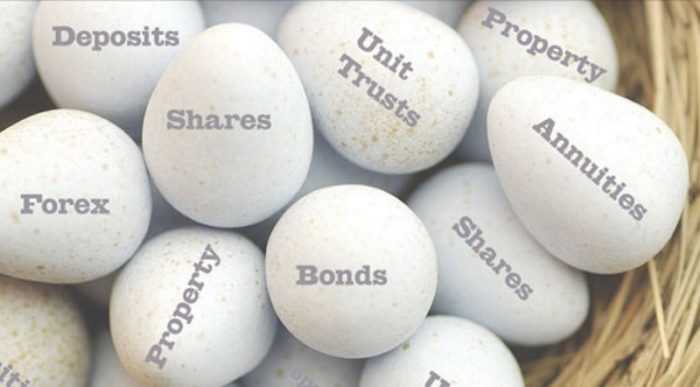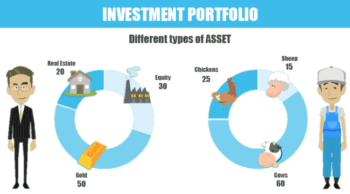
When stock prices drop, bond prices increase. A portfolio that holds stocks and bonds plays better than the one that holds only stocks.
Diversification means to spread the risk across different types of investments. The main purpose of diversification is to enhance your chances of investment success. In other words, you are betting on every one.
Diversification is very important in investing because markets can be volatile and extremely unpredictable. If you diversify your portfolio, you will reduce the chance to lose more than you are prepared to.
And that is exactly what you would like in investing: to spread your capital among different assets. So you’re not relying on a single asset for all of your returns. The key advantage of diversification is that it provides you to minimize the risk of losing the capital invested.
What is diversification?
Diversification means building a portfolio of your investments in a way that the majority of the assets will have a different reaction to the same market performance. For example, when the economy is growing, stocks will outperform bonds. In opposite circumstances, bonds could play better than stocks. Hence, if you hold both stocks and bonds, you will reduce the risks in your portfolio from market swings.
Let’s make this more clear. What do you have in your pantry? Only beans? Of course not! When you went to the grocery you bought everything you need for the week or month ahead. The same should be with your investment portfolio. It should consist of various assets. But not too many. Too many assets mean you will not be able to follow their performances. If you are fresh in the stock market, maybe a two-fund portfolio is a good choice for you. More about this you can read HERE.
Think of these various types of groceries as the different areas, techniques, and areas available to you as an investor. If you have a variety of assets, you’ll be better protected. In the situation when one of your assets is hit by the risk you will still have the others that can give you a profit.
Reasons for diversification
Even the explanation is so simple you can still find so many investors that play on one card. You may ask how some really smart guys could avoid diversification and put all eggs in one basket? We couldn’t find the proper answer because the benefits are so obvious.
By diversification, investors lower the overall risk. It is logical how this works. When you spread your investments in various classes (diversifying them) you have more chances to avoid the negative influence in your portfolio. For example, let’s say you invested in stocks only and you hold a stock of just one company. Yes, we know you like it, it is a good company, famous, well-run. But if suddenly something unpleasant hit it and the stock price drops, let’s say, for 30%, how that occasion will influence your overall portfolio? You will lose 30% of your portfolio. But let’s consider the other situation. Let’s say that stock makes up a modest part of 5% in your portfolio. So, how much of your overall portfolio you will lose now? Can you see where is the benefit of diversification? It lowers the risk. Even during economic downturns, you will still have good players in your portfolio. Hence, if you have bonds and stocks added to your portfolio, it is more likely that even one of them will run well during particular circumstances. Bonds will play better when the economy is decreasing, but when the economy is growing, stocks will outperform bonds.
Diversification and investment strategy
You can find various investment strategies but two are most popular: growth and value investing.
Value investors tend to consider the strength of a company and its management. They would estimate if the company’s stock price is undervalued based on its true worth.
On the other side, growth investors would estimate how fast the company is growing, could its new products stimulate future earnings, etc.
By taking just one strategy you can miss out on the benefits of the other. But if you spread your investments on both of these strategies, it is pretty sure that you’ll be able to enjoy the benefits of each.
Influence of “home country bias”
Well, it is completely natural that investors are more attracted to their own state markets, the national industry. That’s how we come to the “home country bias” in investing. Of course, it is a natural tendency. But it can be a problem too. “Home country bias” can limit your investments to the offer from domestic markets. But what is needed for profitable and successful investing is to step out of your comfort zone. Foreign markets can be profitable also. What you have to do as an investor is to add some international fund or company to your portfolio. It is good protection and well-done diversification. Diversification across international markets will protect your investments if the domestic economy downturns (no one wants that, of course) or during the recession in your country. Several years ago we heard one of the investors saying it isn’t a patriotic gesture. Well, we have to say, investing isn’t an act of patriotism. It is all about profit.
Produces more opportunities
Eventually, diversification produces more opportunities if you make smart choices that deliver balance to your investment portfolio.
For example, you only invest in stocks. But suddenly some great opportunity occurs to invest in, for example, bonds. What will you do? Refuse to invest in bonds because you are not comfortable with them and risk to miss potential profit? We don’t think it is a smart idea. Never miss the opportunity to earn more, that isn’t in the nature of investing. Admit, you will never miss this opportunity to invest in bonds if you have a diversified portfolio. So, diversification gives you more opportunities to invest.
Protect and improve your finances
It is important to understand all the benefits of diversification. It isn’t hard to do. Actually, it is very simple. You have to read more, learn and be patient. If you diversify your investment portfolio you will have a chance to build stable finances over time.
How to diversify your portfolio
Firstly, never be too much invested. You will not be the winner if you own hundreds of assets. Okay, let’s say this way. Your portfolio is your team. And, as in every team, each part plays its role. No coach will put all players in one position. It’s stupid. Plus, how such a team will win anything? Of course, zero chances!
The point of diversifying is to hold investments that able to work separated tasks on your team.
Every single part of your portfolio should have a different role. For example, if you prefer stocks, diversify your portfolio to S&P 500 (that would provide you exposure to large-caps) and add some small-caps.
If you have a bond portfolio diversify it across short and long bonds, or higher-quality bonds, etc. That will reduce the risks. Or just add alternative investments in your portfolio. For example, private equity, hedge funds, real property, venture capital, commodities, etc.
Bottom line
How will you know you’re diversified? A well-diversified investment portfolio will never move in the same trend and at the same time. You must have one thing on your mind: you are the manager of your portfolio. Also, it is almost impossible for all investments to grow all the time. It is 100% sure that some of your positions will be lost, will lose you money. When that happens you will need the other holdings to balance that fall.
Diversification guards you against producing an undesired risk to your capital. Anyway, it is too risky to put all your money into one single investment. The key to diversification is to spread your money across asset classes and to allocate within classes. That is a smart approach.







